Occupant Kinematic and Injury Responses in Zero-Gravity Seat Under Low-, Medium-, and High-Speed Rear Impacts with Different Seat Belt Systems
Abstract
1. Introduction
2. Materials and Methods
2.1. Validation of the Finite Element Model of Occupant Restraint Systems with a Regular Seat Model and a Three-Point Seat Belt System
2.2. Creation of the Finite Element Model of the Zero-Gravity Seat
2.3. Finite Element Model Assembly of Occupant Restraint Systems in Zero-Gravity Seats with Different Seat Belt Systems
2.4. Rear-Impact Loading Conditions and Injury Measurement
3. Results
3.1. Kinematic Responses of Occupants in Zero-Gravity Seat with Three-Point Seat Belts at Different Impact Speeds
3.2. Injury Response of Occupants in Zero-Gravity Seats with 3-Point Seat Belt
3.3. Occupant Responses in Zero-Gravity Seat with Four-Point Seat Belt at High-Speed Rear Impact
4. Discussion
5. Conclusions
Author Contributions
Funding
Institutional Review Board Statement
Informed Consent Statement
Data Availability Statement
Conflicts of Interest
References
- Han Kim, K.; Young, K.S.; Rajulu, S.L. Neutral body posture in spaceflight. In Proceedings of the Human Factors and Ergonomics Society Annual Meeting, Seattle, WA, USA, 28 October–1 November 2019; pp. 992–996. [Google Scholar]
- NASA. Anthropometry and Biomechanics. Available online: https://www.nasa.gov/directorates/esdmd/hhp/anthropometry-and-biomechanics (accessed on 11 January 2024).
- NASA. NASA Standards Inform Comfortable Car Seats. Available online: https://spinoff.nasa.gov/Spinoff2013/t_4.html (accessed on 16 February 2024).
- Shen, W. A Review of Reclined Occupant Crash Injuries and Impact Protection. Automot. Eng. 2024, 46, 2241–2256. [Google Scholar] [CrossRef]
- Chen, Y.; Yu, Z. Postural Effects on Occupant Injury Dynamics: A Computational Study of Hybrid III Anthropomorphic Test Device in Weightless Collision Scenarios. Automob. New Powertrain 2023, 6, 35–37. [Google Scholar] [CrossRef]
- Mroz, K.; Östling, M.; Richardson, R.; Kerrigan, J.; Forman, J.; Gepner, B.; Lubbe, N.; Pipkorn, B. Effect of seat and seat belt characteristics on the lumbar spine and pelvis loading of the SAFER human body model in reclined postures. In Proceedings of the IRCOBI Conference; 2020; pp. 470–486. Available online: https://www.ircobi.org/wordpress/downloads/irc20/pdf-files/58.pdf (accessed on 25 May 2025).
- Östling, M.; Lundgren, C.; Lubbe, N.; Pipkorn, B. Reducing lumbar spine vertebra fracture risk with an adaptive seat track load limiter. Front. Future Transp. 2022, 3, 890117. [Google Scholar] [CrossRef]
- Tong, F.; Wang, Y.; Jian, Q.; Lan, F.; Chen, J. The effectiveness of swiveling seats in protecting reclined occupants in highly autonomous driving environments during frontal crashes. Appl. Sci. 2023, 14, 349. [Google Scholar] [CrossRef]
- Carlsson, A.; Siegmund, G.P.; Linder, A.; Svensson, M.Y. Motion of the head and neck of female and male volunteers in rear impact car-to-car impacts. Traffic Inj. Prev. 2012, 13, 378–387. [Google Scholar] [CrossRef] [PubMed]
- Viano, D.C.; Olsen, S. The effectiveness of active head restraint in preventing whiplash. J. Trauma Acute Care Surg. 2001, 51, 959–969. [Google Scholar] [CrossRef] [PubMed]
- Hasija, V.; Kelkar, R.; Takhounts, E.G. Simulation assessment of injury trends for 50th percentile males using potential seating configurations of future automated driving system (ADS) equipped vehicles. In Proceedings of the 26th International Technical Conference on the Enhanced Safety of Vehicles (ESV): Technology: Enabling a Safer TomorrowNational Highway Traffic Safety Administration, Eindhoven, The Netherlands, 10–13 June 2019. [Google Scholar]
- Ngo, A.V.; Becker, J.; Thirunavukkarasu, D.; Urban, P.; Koetniyom, S.; Carmai, J. Investigation of occupant kinematics and injury risk in a reclined and rearward-facing seat under various frontal crash velocities. J. Saf. Res. 2021, 79, 26–37. [Google Scholar] [CrossRef] [PubMed]
- Wu, H.; Bian, C.; Hu, L.; Gong, C. Research on Injury of Occupants with Different Postures in Rear End Impacts during Automatic Driving. China Mech. Eng. 2023, 34, 1628–1637. [Google Scholar] [CrossRef]
- Rouhana, S.W.; Bedewi, P.G.; Kankanala, S.V.; Prasad, P.; Zwolinski, J.J.; Meduvsky, A.G.; Rupp, J.D.; Jeffreys, T.A.; Schneider, L.W. Biomechanics of 4-point seat belt systems in frontal impacts. Stapp Car Crash J. 2003, 47, 367–399. [Google Scholar] [CrossRef] [PubMed]
- Caballero-Bruno, I.; Wohllebe, T.; Töpfer, D.; Hernández-Castellano, P.M. The effect of seating recline on sleep quality, comfort and pressure distribution in moving autonomous vehicles. Appl. Ergon. 2022, 105, 103844. [Google Scholar] [CrossRef] [PubMed]
- CCSA. 2012 Toyota Camry Detailed Finite Element Model Version 5a. Available online: https://www.ccsa.gmu.edu/models/2012-toyota-camry/ (accessed on 20 November 2023).
- Kang, Y.S.; Moorhouse, K.; Icke, K.; Herriott, R.; Bolte, J.; John, H. Head and cervical spine responses of post mortem human subjects in moderate speed rear impacts. In Proceedings of the IRCOBI Conference, Berlin, Germany, 10–12 September 2014; pp. 268–285. [Google Scholar]
- Kang, Y.S.; Moorhouse, K.; Bolte, J.H., IV. Head trajectories of post mortem human surrogates in moderate-speed rear impacts. In Proceedings of the Conference proceedings International Research Council on the Biomechanics of Injury, IRCOBI, Florence, Italy, 11–13 September 2019; pp. 102–118. [Google Scholar]
- Zhang, X.R.; Feng, B.C.; Xue, Z.X.; Liu, Y.; Ye, X.; Tu, W.Q. The effectiveness of Q6 and PIPER 6-year-old models on quantification of the change of child sitting posture with AEB and its impact on child’s injures in frontal crash. Traffic Inj. Prev. 2024, 25, 825–831. [Google Scholar] [CrossRef] [PubMed]
- Muser, M.; Walz, F.; Zellmer, H. Biomechanical significance of the rebound phase in low speed rear end impacts. In Proceedings of the IRCOBI Conference, Montpellier, France, 20–22 September 2000; pp. 411–424. [Google Scholar]
- NHTSA. Vehicle Interior and Restraint Modeling of 2014 Honda Accord. Available online: https://www.nhtsa.gov/file-downloads?p=nhtsa/downloads/NRD/Research/Crash-Simulation-Vehicle-Models/Oblique-Accord-Updated-PAB/ (accessed on 20 November 2023).
- AITO. M9ev Product Manual. Available online: https://aito.auto/service/ (accessed on 30 December 2024).
- van Ratingen, M.; Ellway, J.; Avery, M.; Gloyns, P.; Sandner, V.; Versmissen, T. The Euro NCAP whiplash test. In Proceedings of the 21st International Technical Conference on the Enhanced Safety of Vehicles, Stuttgart, Germany, 15–18 June 2009. [Google Scholar]
- U.S. Department of Transportation. Federal Motor Vehicle Safety Standard No. 301: Fuel System Integrity. Code of Federal Regulations. § 571.301. 2004. Available online: https://www.ecfr.gov/current/title-49/subtitle-B/chapter-V/part-571/subpart-B/section-571.301 (accessed on 25 May 2025).
- United Nations Economic Commission for Europe. Regulation No. 94: Uniform Provisions Concerning the Approval of Vehicles with Regard to the Protection of the Occupants in the Event of a Frontal Collision. 1995. Revised 2022. Available online: https://unece.org/sites/default/files/2024-07/R094r4e.pdf (accessed on 25 May 2025).
- Bridges, W.; Ganesan, V.; Jayakumar, P.; Davies, J.; Paramasuwom, M. Front Seat Modeling in Rear Impact Crashes: Development of a Detailed Finite-Element Model for Seat Back Strength Requirements; No. DOT HS 812 737; United States Department of Transportation, National Highway Traffic Safety Administration: Washington, DC, USA, 2019.
- Albert, D.L.; Beeman, S.M.; Kemper, A.R. Occupant kinematics of the Hybrid III, THOR-M, and postmortem human surrogates under various restraint conditions in full-scale frontal sled tests. Traffic Inj. Prev. 2018, 19, S50–S58. [Google Scholar] [CrossRef] [PubMed]
- CEN/TS 17342:2019; Road Restraint Systems. Motorcycle Road Restraint Systems Which Reduce the Impact Severity of Motor Cyclist Collisions with Safety Barriers. European Committee for Standardization: Bruxelles, Belgium, 2019.
- Takhounts, E.G.; Craig, M.J.; Moorhouse, K.; McFadden, J.; Hasija, V. Development of brain injury criteria (BrIC). Stapp Car Crash J. 2013, 57, 243–266. [Google Scholar] [CrossRef] [PubMed]
- Kleiven, S. Predictors for Traumatic Brain Injuries Evaluated Through Accident Reconstructions; No. 2007-22-0003. SAE Technical Paper; The Stapp Association: Washington, DC, USA, 2007. [Google Scholar]
- Bandak, F.; Eppinger, R.; Haffner, M.; Khaewpong, N.; Kuppa, S.; Maltese, M.; Nguyen, T.; Saul, R.; Sun, E.; Takhounts, E. Development of Improved Injury Criteria for the Assessment of Advanced Automotive Restraint Systems: II; United States. Department of Transportation. National Highway Traffic Safety Administration. 1999. Available online: https://rosap.ntl.bts.gov/view/dot/14738 (accessed on 25 May 2025).
- Schmitt, K.-U.; Muser, M.H.; Niederer, P. A New Neck Injury Criterion Candidate for Rear-End Collisions Taking into Account Shear Forces and Bending Moments. No. 2001-06-0175. SAE Technical Paper. 2001. Available online: https://www-nrd.nhtsa.dot.gov/pdf/esv/esv17/proceed/00175.pdf (accessed on 25 May 2025).
- Svensson, M.; Aldman, B.; Hansson, H.; Lovsund, P.; Seeman, T.; Suneson, A.; Ortemgren, T. Pressure Effects in the Spinal Canal During Whiplash Extension Motion. In Proceedings of the IRCOBI Conference, Eindhoven, The Netherlands, 8–10 September 1993; pp. 189–200. [Google Scholar]
- Ellway, J.; Hallbauer, K.; Kerz, T. The development of a Euro NCAP far side occupant test and assessment procedure. In Proceedings of the 26th International Technical Conference on the Enhanced Safety of Vehicles (ESV), Eindhoven, The Netherlands, 10–13 June 2019. [Google Scholar]
- European New Car Assessment Programme. TB 035—Brain Injury Calculation v1.0.2022. Available online: https://cdn.euroncap.com/media/67886/tb-035-brain-injury-calculation-v10.pdf (accessed on 25 May 2025).
- Hollowell, W.T.; Gabler, H.C.; Stucki, S.L.; Summers, S.; Hackney, J.R. Updated Review of Potential Test Procedures for FMVSS No. 208; NHTSA Docket. 1999. Available online: https://www.nhtsa.gov/sites/nhtsa.gov/files/fmvss_208_ii.pdf (accessed on 25 May 2025).
- Yoganandan, N.; Kumaresan, S.; Pintar, F.A. Geometric and mechanical properties of human cervical spine ligaments. J. Biomech. Eng.-Trans. Asme 2000, 122, 623–629. [Google Scholar] [CrossRef] [PubMed]
- Jin, X.; Hou, H.; Shen, M.; Wu, H.; Yang, K.H. Occupant kinematics and biomechanics with rotatable seat in autonomous vehicle collision: A preliminary concept and strategy. In Proceedings of the 2018 IRCOBI Conference Proceeding, IRCOBI, Athens, Greece, 12–14 September 2018. [Google Scholar]
- Correia, M.A.; McLachlin, S.D.; Cronin, D.S. Optimization of muscle activation schemes in a finite element neck model simulating volunteer frontal impact scenarios. J. Biomech. 2020, 104, 109754. [Google Scholar] [CrossRef] [PubMed]
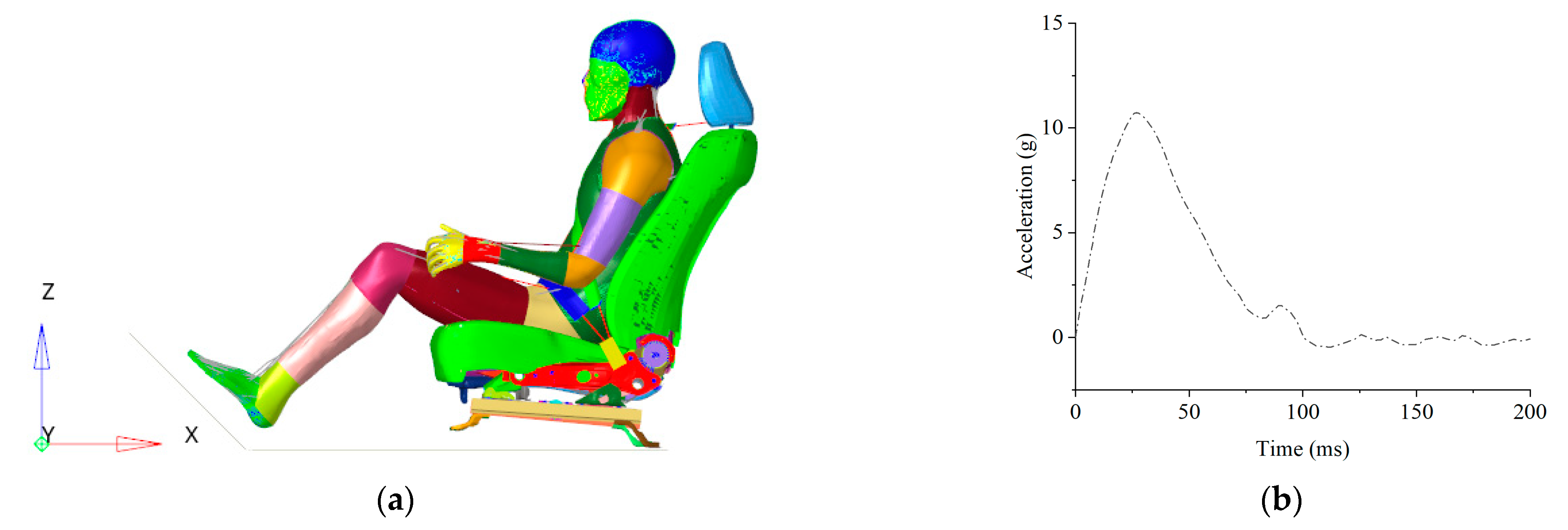
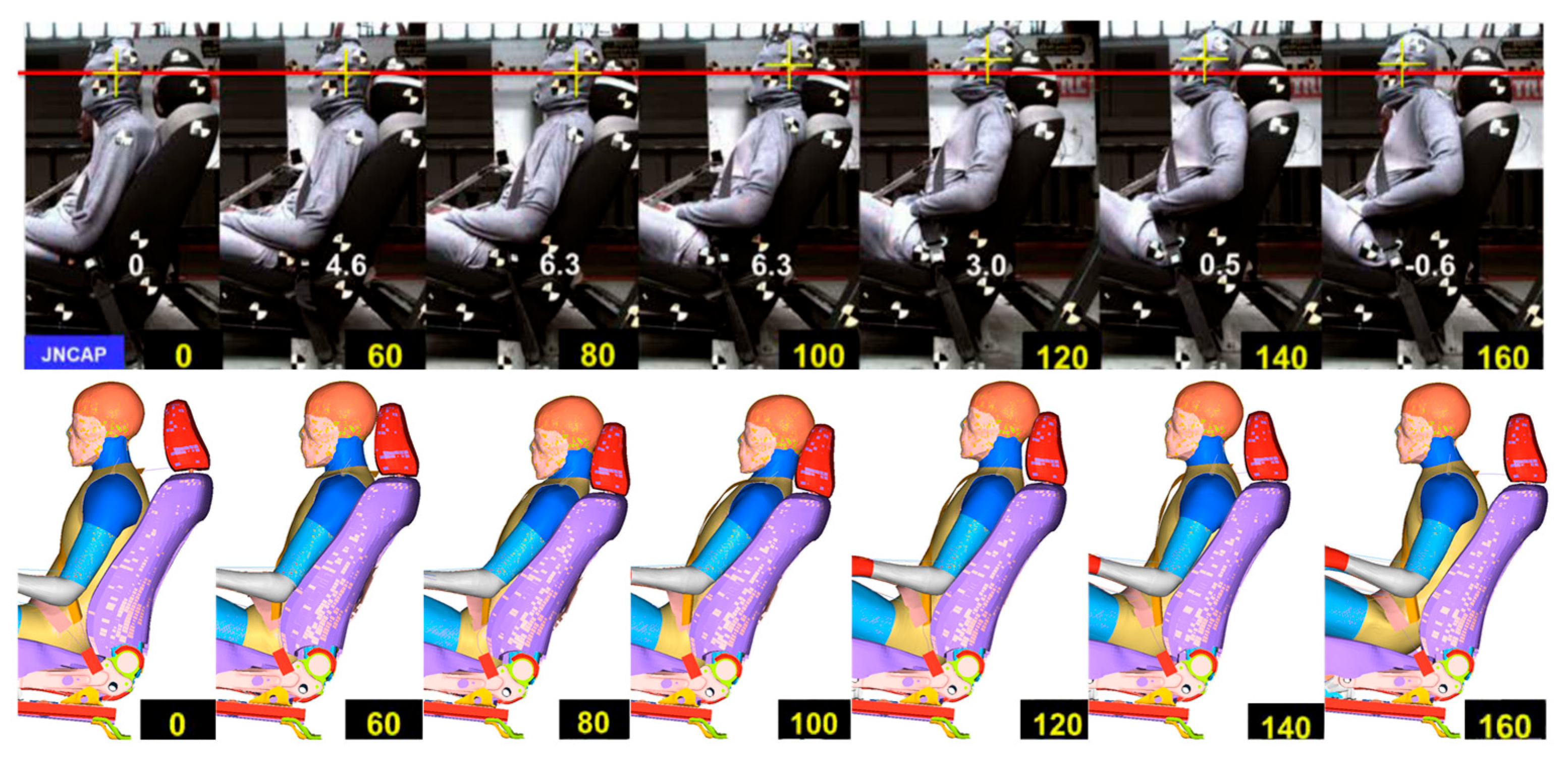
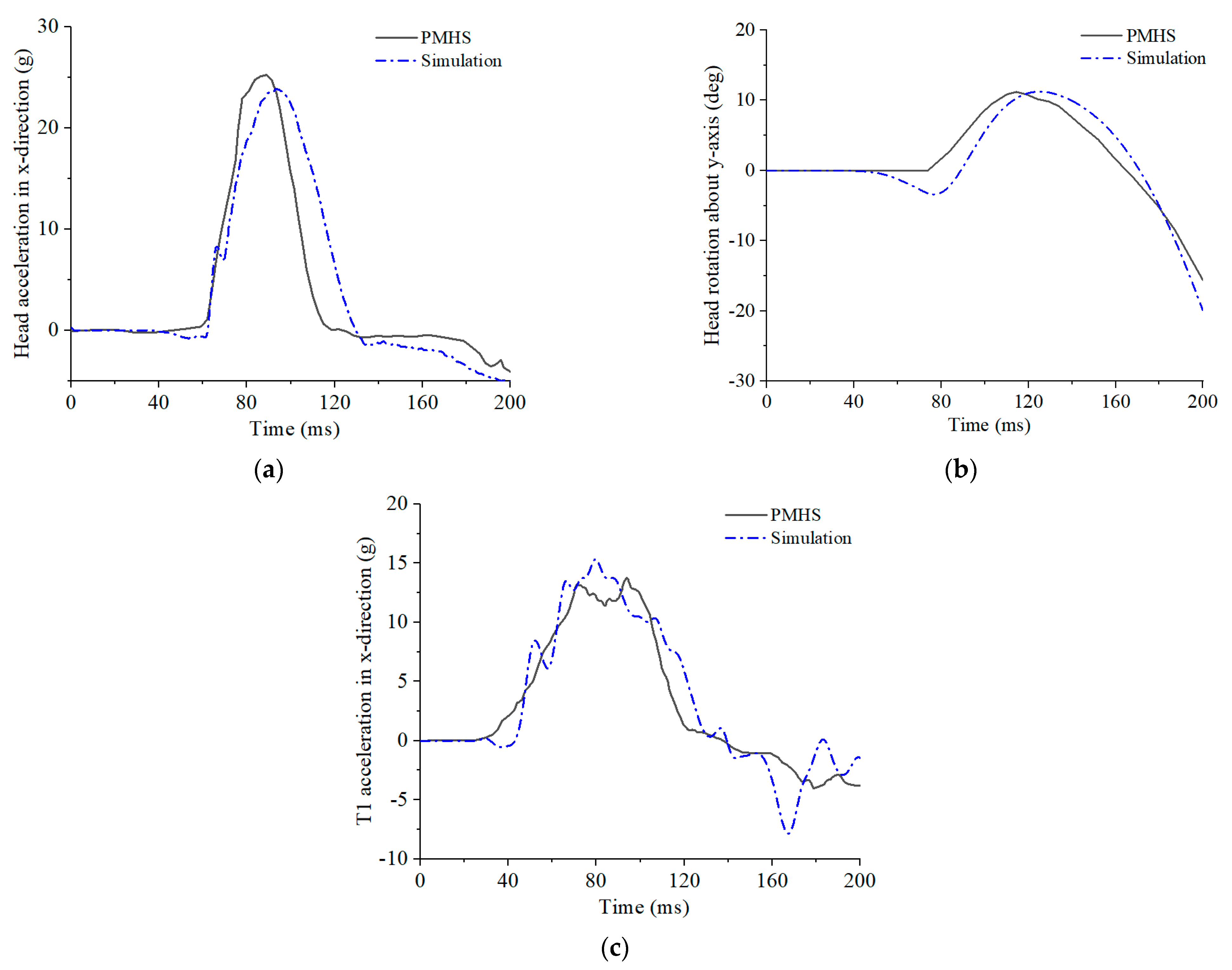

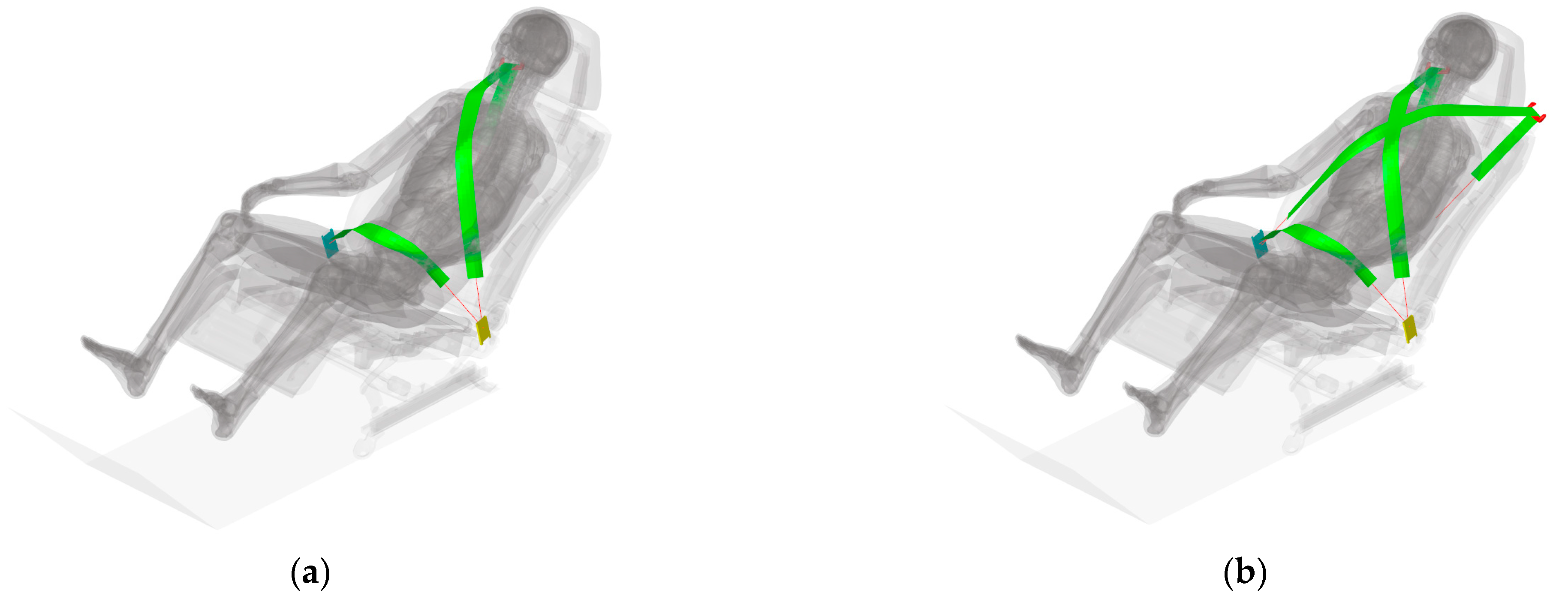






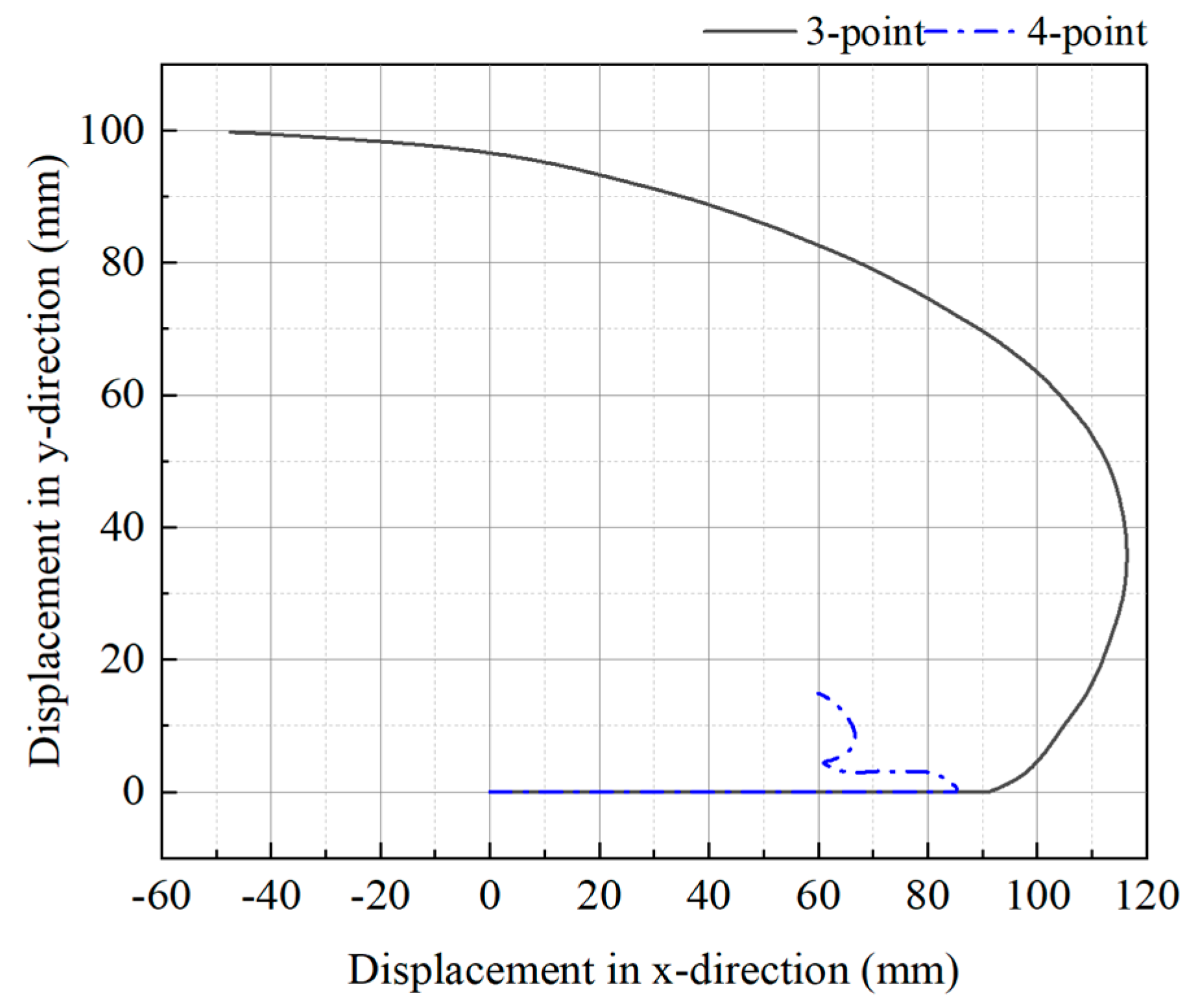
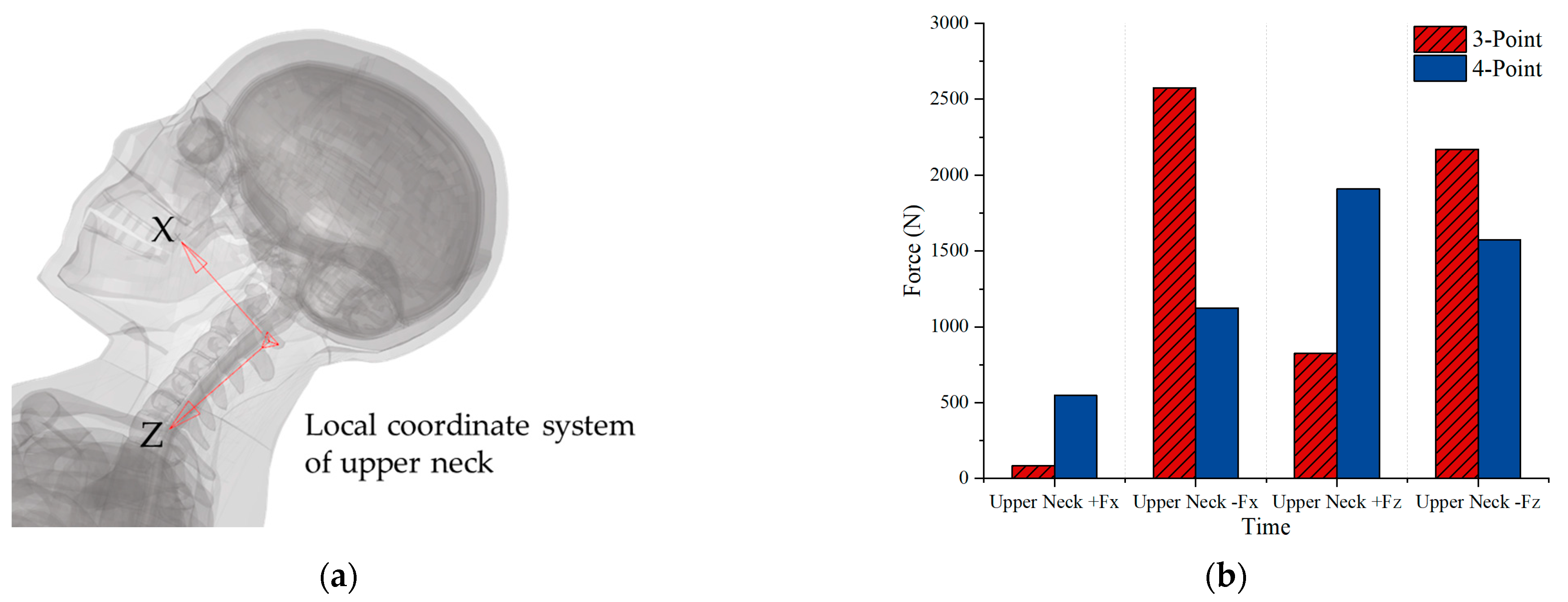
| Seat Belt Thickness (mm) | Seat Belt Width (mm) | Retractor to Seatback (mm) | Shoulder Guide Loop to Centerline (mm) |
|---|---|---|---|
| 1.2 | 48 | 72 | 183 |
| Response | Corridor Score | Cross-Correlation Scores | CORA Score |
|---|---|---|---|
| Head acceleration | 0.72 | 0.74 | 0.73 |
| T1 acceleration | 0.71 | 0.88 | 0.79 |
| Head rotation about y | 0.67 | 0.81 | 0.74 |
| Speed (km/h) | BrIC | CSDM (0.25) (vol%) | Nij | Nkm | NIC (m2/s2) |
|---|---|---|---|---|---|
| 16 | 0.14 | 0.6 | 0.16 | 0.14 | 6.48 |
| 40 | 0.46 | 21 | 0.23 | 0.57 | 14.9 |
| 56 | 1.16 | 58 | 0.49 | 3.08 | 72.7 |
| Speed (km/h) | ALL | PLL | CL | LF | ISL |
|---|---|---|---|---|---|
| Thresholds [37] | 0.35 | 0.34 | 1.48 | 0.88 | 0.68 |
| 16 | 0.12 | 0.17 | 0.29 | 0.12 | 0.52 |
| 40 | 0.25 | 0.29 | 0.51 | 0.28 | 0.53 |
| 56 | 0.69 | 1.59 | 2.64 | 0.48 | 1.46 |
| Belt Type | BrIC | CSDM (0.25) (vol%) | Nij | Nkm | NIC (m2/s2) |
|---|---|---|---|---|---|
| 3-Point | 1.16 | 58 | 0.49 | 3.08 | 72.7 |
| 4-Point | 0.39 | 17 | 0.38 | 1.46 | 44.1 |
| Belt Type | ALL | PLL | CL | LF | ISL |
|---|---|---|---|---|---|
| Thresholds [37] | 0.35 | 0.34 | 1.48 | 0.88 | 0.68 |
| 3-Point | 0.69 | 1.59 | 2.64 | 0.48 | 1.46 |
| 4-Point | 0.43 | 0.76 | 1.12 | 0.37 | 0.79 |
Disclaimer/Publisher’s Note: The statements, opinions and data contained in all publications are solely those of the individual author(s) and contributor(s) and not of MDPI and/or the editor(s). MDPI and/or the editor(s) disclaim responsibility for any injury to people or property resulting from any ideas, methods, instructions or products referred to in the content. |
© 2025 by the authors. Licensee MDPI, Basel, Switzerland. This article is an open access article distributed under the terms and conditions of the Creative Commons Attribution (CC BY) license (https://creativecommons.org/licenses/by/4.0/).
Share and Cite
Tu, W.; Zhang, P.; Zhang, J.; Liu, Y.; Ye, X.; Zhang, X. Occupant Kinematic and Injury Responses in Zero-Gravity Seat Under Low-, Medium-, and High-Speed Rear Impacts with Different Seat Belt Systems. Appl. Sci. 2025, 15, 6388. https://doi.org/10.3390/app15126388
Tu W, Zhang P, Zhang J, Liu Y, Ye X, Zhang X. Occupant Kinematic and Injury Responses in Zero-Gravity Seat Under Low-, Medium-, and High-Speed Rear Impacts with Different Seat Belt Systems. Applied Sciences. 2025; 15(12):6388. https://doi.org/10.3390/app15126388
Chicago/Turabian StyleTu, Wenqiong, Peiwen Zhang, Jing Zhang, Yang Liu, Xin Ye, and Xuerong Zhang. 2025. "Occupant Kinematic and Injury Responses in Zero-Gravity Seat Under Low-, Medium-, and High-Speed Rear Impacts with Different Seat Belt Systems" Applied Sciences 15, no. 12: 6388. https://doi.org/10.3390/app15126388
APA StyleTu, W., Zhang, P., Zhang, J., Liu, Y., Ye, X., & Zhang, X. (2025). Occupant Kinematic and Injury Responses in Zero-Gravity Seat Under Low-, Medium-, and High-Speed Rear Impacts with Different Seat Belt Systems. Applied Sciences, 15(12), 6388. https://doi.org/10.3390/app15126388






